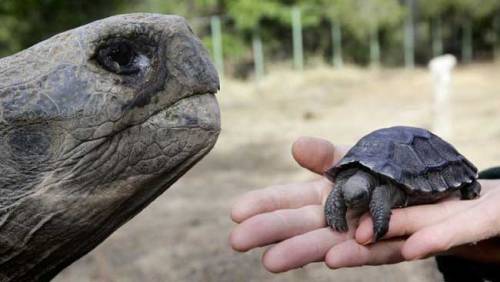Baby Tortoises Show Up In The Galapagos For The First Time In Over A Century

Baby Tortoises Show Up In The Galapagos For The First Time In Over A Century
There hadn’t been one single baby tortoise sighting in more than a century on the Galapagos Island of Pinzon, until a small group of the tiny, shelled youngsters were spotted this year.
The recent births are helping to pull the critically endangered animals back from the brink of extinction after they were nearly laid to waste as a result of human activity.
This is huge news for a species that has been struggling to survive for a century, relying on humans raising young tortoises bred in captivity until they are large enough to not fall prey to rats and predators.
More Posts from Science-is-magical and Others

A group of astronomers is using a new method to search for hard to spot alien planets: By measuring the difference between the amount of light coming from the planets’ daysides and nightsides, astronomers have spotted 60 new worlds thus far.
Continue Reading.

Scientists have discovered the world’s oldest known water in an ancient pool in Canada that’s at least 2 billion years old.
Back in 2013 they found water dating back about 1.5 billion years at the Kidd Mine in Ontario, but searching deeper at the site revealed an even older source buried underground.
The initial discovery of the ancient liquid in 2013 came at a depth of around 2.4 kilometres (1.5 miles) in an underground tunnel in the mine. But the extreme depth of the mine – which at 3.1 kilometres (1.9 miles) is the deepest base metal mine in the world – gave researchers the opportunity to keep digging.
“[The 2013 find] really pushed back our understanding of how old flowing water could be and so it really drove us to explore further,” geochemist Barbara Sherwood Lollar from the University of Toronto told Rebecca Morelle at the BBC.
“And we took advantage of the fact that the mine is continuing to explore deeper and deeper into the earth.”
The new source was found at about 3 kilometres (1.9 miles) down, and according to Sherwood Lollar, there’s a lot more of it than you might expect.
Continue Reading.
Good news today: the fastest horizontal flyer in the animal kingdom is now a bat.
Free-tailed bats have now been clocked flying horizontally at over 160 kilometers per hour (that’s nearly 100 mph!), toppling the previous record-holder, the swift. The record for speed of diving is still held by the peregrine falcon but we’re coming for you next, feathers.
Source

Machine Learning: An In-Depth, Non-Technical Guide
A good introductory text in five parts:
Overview, goals, learning types, and algorithms
Data selection, preparation, and modeling
Model evaluation, validation, complexity, and improvement
Model performance and error analysis
Unsupervised learning, related fields, and machine learning in practice
By Alex Castrounis - {InnoArchiTech}


Timelapse of Europa & Io orbiting Jupiter, shot from Cassini during its flyby of Jupiter
Absence of Serotonin Alters Development and Function of Brain Circuits
Researchers at Case Western Reserve University School of Medicine have created the first complete model to describe the role that serotonin plays in brain development and structure. Serotonin, also called 5-hydroxytryptamine [5-HT], is an important neuromodulator of brain development and the structure and function of neuronal (nerve cell) circuits. The results were published in the current issue of The Journal of Neurophysiology online.
“Our goal in the project was to close the gap in knowledge that exists on role of serotonin in the brain cortex, particularly as it concerns brain circuitry, its electrical activity and function,” said Roberto Fernández Galán, PhD, Assistant Professor in the Department of Neurosciences at Case Western Reserve University School of Medicine. “For the first time, we can provide a complete description of an animal model from genes to behavior—including at the level of neuronal network activity, which has been ignored in most studies to date.”
Dr. Galán and his team used high-density multi-electrode arrays in a mouse model of serotonin deficiency to record and analyze neuronal activity. The study supports the importance of the serotonin which is specified and maintained by a specific gene, the Pet-1 gene – for normal functioning of the neurons, synapses and networks in the cortex, as well as proper development of brain circuitry. Serotonin abnormalities have been linked to autism and epilepsy, depression and anxiety. By more fully elucidating the role of serotonin in the brain, this study may contribute to a better understanding of the development or treatment of these conditions.
“By looking at the circuit level of the brain, we now have new insight into how the brain becomes wired and sensitive to changing serotonin levels.” added Dr. Galán.
-
 lulisbae reblogged this · 2 weeks ago
lulisbae reblogged this · 2 weeks ago -
 babajagka liked this · 2 years ago
babajagka liked this · 2 years ago -
 babajagka reblogged this · 2 years ago
babajagka reblogged this · 2 years ago -
 shapelessamalgamationofanxiety liked this · 2 years ago
shapelessamalgamationofanxiety liked this · 2 years ago -
 starlitvoyeur liked this · 3 years ago
starlitvoyeur liked this · 3 years ago -
 arrhythmia-on-avalon reblogged this · 3 years ago
arrhythmia-on-avalon reblogged this · 3 years ago -
 groundcinnamon2 liked this · 3 years ago
groundcinnamon2 liked this · 3 years ago -
 delightsofademigodess reblogged this · 4 years ago
delightsofademigodess reblogged this · 4 years ago -
 sticksmatch liked this · 4 years ago
sticksmatch liked this · 4 years ago -
 madebymaryssa liked this · 4 years ago
madebymaryssa liked this · 4 years ago -
 secretcomets liked this · 4 years ago
secretcomets liked this · 4 years ago -
 thatdarnmusicgeek reblogged this · 4 years ago
thatdarnmusicgeek reblogged this · 4 years ago -
 jardya reblogged this · 4 years ago
jardya reblogged this · 4 years ago -
 sukikabuki liked this · 4 years ago
sukikabuki liked this · 4 years ago -
 dootsuite reblogged this · 5 years ago
dootsuite reblogged this · 5 years ago -
 dootsuite liked this · 5 years ago
dootsuite liked this · 5 years ago -
 ithinkthatyouarewonderful liked this · 5 years ago
ithinkthatyouarewonderful liked this · 5 years ago -
 13moons-and-a-single-sun liked this · 5 years ago
13moons-and-a-single-sun liked this · 5 years ago -
 thousand-years-dreaming liked this · 5 years ago
thousand-years-dreaming liked this · 5 years ago -
 slick-back-paddy-whack reblogged this · 5 years ago
slick-back-paddy-whack reblogged this · 5 years ago -
 slick-back-paddy-whack liked this · 5 years ago
slick-back-paddy-whack liked this · 5 years ago -
 squanch reblogged this · 5 years ago
squanch reblogged this · 5 years ago -
 2wizards reblogged this · 5 years ago
2wizards reblogged this · 5 years ago -
 prussian-grenadier reblogged this · 5 years ago
prussian-grenadier reblogged this · 5 years ago -
 tragicsandwiches reblogged this · 5 years ago
tragicsandwiches reblogged this · 5 years ago -
 tragicsandwiches liked this · 5 years ago
tragicsandwiches liked this · 5 years ago -
 pumpkinsforsale reblogged this · 5 years ago
pumpkinsforsale reblogged this · 5 years ago -
 treypug liked this · 5 years ago
treypug liked this · 5 years ago -
 thebladeofdawn reblogged this · 5 years ago
thebladeofdawn reblogged this · 5 years ago


